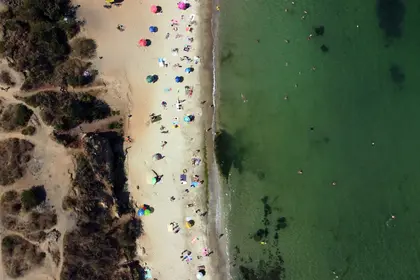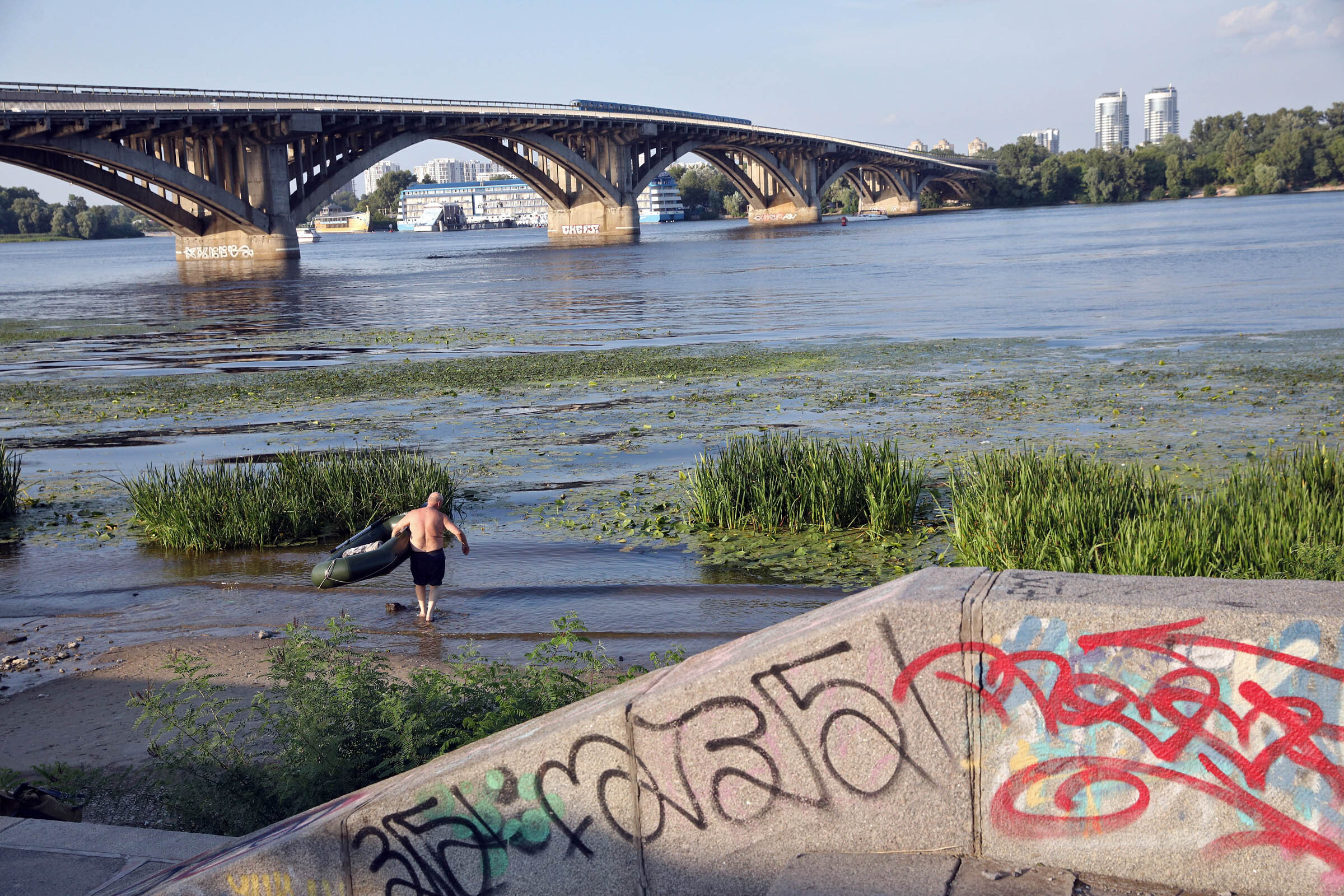Kyiv resident Natalia Vakulenko planned to take her two children to the beach to escape the heat on a summer day in July.
The family was about to leave home when Vakulenko came across a Facebook post that made her change her mind.
“It contained pictures of the Dnipro River being so dirty, I couldn’t even look at it,” Vakulenko told the Kyiv Post.
They never made it to the beach that day and don’t plan to go any time soon.
“Although my kids love to swim and there are not so many options in Kyiv, we would rather not swim at all than swim in these polluted waters,” she said.
The issue is deeper than simple aesthetics.
This year, over 160 pollutants including chemicals and metals have been found in Dnipro, Ukraine’s longest river, according to Ukraine’s Accounting Chamber’s report published on June 29. The situation is a threat to human health and can cause ecological disaster, the report says.
The water pollution issue has been lingering for years and is nothing new to Kyivans. Every summer, locals face the dilemma of swimming in the dirty Dnipro or waiting for a vacation by the sea, if they can afford it.
But even traveling south to Ukraine’s Black and Azov seas is not a solution. The litter, chemicals and other industrial waste in Ukrainian rivers eventually end up in both of the country’s seas, says Ruslan Havryliuk, the head of the National Ecological Center of Ukraine.
Poor water management, industrial pollution and global climate change, which aggravates the situation, are to blame, experts say. But while the causes are known, authorities do nearly nothing to remove them.
Industrial burden
Climate change appears to be among the world’s biggest threats nowadays, and it has a drastic effect on water pollution.
The rising temperatures cause rivers to dry out. The year 2013 was the last high-water year for Ukrainian rivers, according to Havryliuk, while 2020 appeared to be among the driest. The country’s second-longest river, Pivdennyi Buh (Southern Bug), for instance, has seen a decrease of its runoff by two-three times in the last 10 years, according to Havryliuk.
The less water there is in a river, the dirtier it becomes — in high-water rivers chemicals get diluted with clean water.
According to Ukraine’s State Environmental Inspectorate, the current concentration of toxic compounds in Ukrainian rivers is 30–40 times higher than the maximum allowable norms.
Overusing water resources by big production is another problem that leaves Ukrainian rivers low and, as a result, more polluted. The energy sector and agriculture are among the leading industries that overuse water resources in Ukraine.
Although the official statistics show the agricultural industry consuming only around 20% of Ukraine’s water resources, the actual numbers are unknown as many of the farms and households are not required to report on the amount of water they use, the local NGO Ecodia reports.
Experts say that agriculture is also one of the main pollutants, contaminating waters with agrochemicals such as pesticides, fertilizers and herbicides.
Sebastien Truffaut, the manager of the Water, Sanitation and Hygiene program (WASH) at UNICEF Ukraine, says that most water samples contain not only industrial chemical compounds, but also chemicals coming from the agricultural sector.
In February, the State Agency of Water Resources found pesticides, industrial chemicals, and even drugs in the waters of Dnipro, Don and Dniester rivers.
Havryliuk says that pharmaceutical companies are also among severe polluters. In some studies, around half of contaminators found in Dnipro come from pharmaceuticals.
The pollution is caused not only by medicine production but also by its consumption. In Ukraine, where most of the medicine can be bought without recipes, many people treat themselves without a doctor’s recommendation and overuse drugs. Some of them aren’t broken down by people’s bodies, ending up in rivers through sewage waters.
“And then we have analgesics and antibiotics and other pollutants that don’t degrade in the Dnipro River,” Havryliuk says.
What aggravates the situation even more is the illegal hazardous waste that is regularly found in Ukraine’s rivers. In winter, about 3,000 canisters full of unknown toxic chemicals were dumped into a tributary of the Irpin River in Kyiv Oblast that flows into Dnipro.
Those toxic chemicals have been poisoning the local environment in the water for months before being removed in April.
Poor wastewater treatment
Chemicals and other waste wouldn’t affect Ukraine’s environment that much if only the country’s wastewater treatment plants would have worked effectively, experts say.
In Ukraine, such plants fail to protect people and the ecosystem from harmful and toxic elements found in wastewater due to their poor condition. KyivVodokanal, a city-owned company that manages water supply and drainage in the capital, and is supposed to filtrate dirty waters, was actually the biggest water polluter in Ukraine in 2018.
Ukrainian ecology expert Oksana Volosko-Demkiv, who is also the head of the Center for Environmental Consulting and Auditing (CECA), says that around 80% of the country’s old wastewater treatment plants are unable to purify water efficiently due to obsolescence.
Another issue is that many factories update their production after getting legal permission to dump waste of a certain composition. Later they start using new chemicals without giving a notice, while the outdated wastewater treatment plants fail to detect them on their own, Volosko-Demkiv says.
Havryliuk says that Ukraine’s wastewater treatment plants can’t keep up with new technologies.
“We didn’t even know about some pollutants that are found in the rivers now,” he says. “Ukraine needs modernization.”
From rivers to seas
Everything that contaminates Ukrainian rivers ends up in the country’s seas eventually.
Recent studies conducted by the European Union, United Nations Development Program (UNDP) and Ukraine’s Ministry of Ecology and Natural Resources, show that the Black Sea pollution poses risks for both marine life and people.
“The concentrations of some priority hazardous chemical substances dangerous for marine and human life exceed their toxicity threshold values,” the report reads.
The studies identified 124 dangerous chemicals in the sea that hadn’t been monitored before.
The report also highlighted the growing litter issue, concluding that the Black Sea is twice as polluted by marine litter as the Mediterranean Sea. Most of it, or 83%, is plastic, namely bottles, packaging and bags. The large rivers such as Danube and Dniester bring to the sea 6–50 items of trash every hour, the report says.
Viktor Komorin, the director of the Ukrainian Scientific Center for Marine Ecology, told Hromadske online media that estimates show that there will be more plastic than fish in the Black Sea by 2050.
Aside from litter and chemicals, the Black Sea water near southern port city Odesa suffers from urine pollution, Volosko-Demkiv says. Though it’s one of the country’s main travel destinations, Odesa lacks proper infrastructure on its public beaches. With few toilets, travelers are forced to use the sea for such purposes.
“It adds to the whole situation with water pollution and only makes it worse,” Volosko-Demkiv says.
Gastroenteritis is the most common illness that can be acquired after swimming in water polluted by sewage. One can also get a staph infection and various skin diseases.Truffaut says that swimming in the chemical-contaminated waters can have some “effects on the skin or even lead to cancer.”
Who’s responsible?
Ukraine has been slowly moving towards a more sustainable treatment of water resources.
In June, the government agreed to gradually limit the number of phosphates in detergents. When dumped into waters, these chemical compounds can cause increased growth of algae and large aquatic plants, causing toxic algal blooming, which is harmful to human health and the environment.
The country is following the footsteps of the EU in the regulation of single-use plastics. The parliament passed a law that bans thin plastic bags.
But this is far from enough to mitigate water pollution in Ukraine.
In order to reduce the number of toxic chemicals and other dangerous waste in the rivers, Ukraine needs to upgrade its wastewater treatment plants, Havryliuk says.
There is a critical need to improve the infrastructure of the beaches and ensure the safe and clean territories around rivers by the authorities.
But the general responsibility for water management should be shared by private companies and the public, experts say.
Volosko-Demkiv says that the industrial enterprises should start the transition to a “circulating water supply system” to stop the overuse of water resources already drained by the climate change. They also should shift to a sustainable approach to waste management.
The population, meanwhile, should practice conscious consumption of resources and products and sort garbage.
“We can’t constantly demand something from our government if we don’t do it ourselves,” Volosko-Demkiv says.
And while Ukraine needs urgent actions to save the local waters, steps to avert future pollution — sometimes as simple as everyday habits — are just as important.
“It’s much easier to prevent pollution than to fix it,” Havryliuk says.
You can also highlight the text and press Ctrl + Enter





